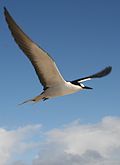Seabird
Seabirds are birds that have adapted so they are better able to live at sea or near it. Many seabirds live at sea, that is, far away from land. They may only come on land to breed. Other seabirds live in colonies on islands. Very often, seabirds use the sea for food, most often fish or shellfish. The first seabirds evolved in the Cretaceous period, and modern seabird families first appeared in the Palaeogene. The similarities between them are examples of convergent evolution. The same environmental problems and feeding niches have resulted in similar adaptations.
Seabirds share a number of adaptations to sea life. They live longer, breed later and have fewer young than other birds. They do spend a great deal of time with their young. Most species nest in colonies. These vary from a few dozen birds to millions. Many species take long annual migrations every year, crossing the equator or circumnavigating the Earth in some cases. They feed both at the ocean's surface and below it, and even feed on each other. Seabirds vary in how much of the year they spend at sea.
Gallery
The sooty tern spends months flying at sea, returning to land only for breeding.[1]
Cormorants have feathers that can get wet. This lets them to dive more easily.
The chinstrap penguin is a streamlined pursuit diver.
Pelicans winter in Cuba every year from North America.
Arctic terns breed in the Arctic and subarctic and winter in Antarctica.
Northern gannets breeding in large colony in Canada
Seabird Media
The sooty tern is highly aerial and marine and spends months flying at sea, returning to land only for breeding.
Raft of coastal seabirds Gulf of St. Lawrence, Quebec, Canada
Wilson's storm petrels pattering on the water's surface
An African penguin skeleton, showing the sternal keel that makes the species a strong diver and swimmer
Northern gannet pair "billing" during courtship; like all seabirds except the phalaropes they maintain a pair bond throughout the breeding season.
Common murres breed on densely packed colonies on offshore rocks, islands and cliffs.
This crested auklet was oiled in Alaska during the spill of MV Selendang Ayu in 2004.
References
- ↑ BirdLife International (BLI) (2008). Sterna fuscata. 2008 IUCN Red List of Threatened Species. IUCN 2008. Retrieved on 7 August 2009.















